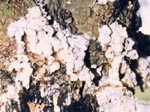Pine Moths
European Pine Shoot Moth Rhyacionia buoliana
Nantucket Pine Tip Moth Rhyacionia frustrana
Zimmerman Pine Moth Dioryctria zimmermani
Description
The small, reddish, adult European and Nantucket pine moths are not likely to be seen, but their larvae or pupae may be found in damaged buds and shoots. The mature larvae of the European pine shoot moth are about 5/8 inch long and have brownish bodies and black heads. The mature larvae of the Nantucket pine tip moth are about 3/8 inch ling and have yellowish bodies and brown heads. The pupae of both are dark brown and slightly smaller than their respective larvae. The adult Zimmerman pine moth is gray with a mottled forewing of red and gray. The mature larvae are pink to green, depending on the host, with black spots containing a single bristle each. The mature larvae are about 3/4 inch long.
Life History
The European pine shoot moth overwinters in the larval stage in the buds of pines. The larvae resume feeding in the spring, complete their development, and pupate. The moths emerge in June to deposit eggs. The Nantucket pine tip moth, on the other hand, overwinters in the pupal stage in the pine twigs. Moths begin to emerge in April to deposit eggs, and they continue to emerge through May. Both of these insects lay flat, inconspicuous eggs on the needles as well as into the buds and shoots. There is only one generation of the European pine shoot moth per year, but there may be two or more generations of the Nantucket pine tip moth in a year.

Figure 1. Zimmerman
Pine Moth Adult
Zimmerman pine moths deposit eggs in mid-August on the bark near the edge of wounds. The larvae hatch in about 2 weeks and spin hibernaculae. Activity resumes the following spring with feeding beginning in May or June. The larvae first feed on the bark and then bore into the cambium, causing the terminals'to turn yellowish-green with extensive accumulations of frass and resin at the crotch of the branch. In late June, the larvae tunnel beneath the bark in the whorl area and later pupate within the resin mass. There is one generation per year.
Damage
The European pine shoot moth is mainly a pest of Scotch, mugho, and red pine in northern Illinois. Pitch at the bud and a few dead needles with webbing are the first indication of an infestation. Larval feeding stunts the twigs ("shepherd's crook") and causes deformed and bush growth. Crooked stems called "post horns" result when a damaged shoot recovers. Injury caused to a bud or shoot by the European pine shoot moth is almost invariably the work of a single larva.
The Nantucket pine tip moth is a pest of loblolly and shortleaf pines, especially those in the southern half of Illinois. Larval feeding kills the shoots, each of which may have several entrance holes with pitch flowing out. Damage may be extensive and, depending on the degree of, infestation, either severe or light. Injury by the Nantucket moth pine tip moth is usually the work of several larvae.

Figure 2. Zimmerman
Pine Moth Damage
The Zimmerman pine moth is a pest of most pine species, with Scotch and Austrian pines being very susceptible. The larval tunneling will girdle branches and leaders and cause dieback.